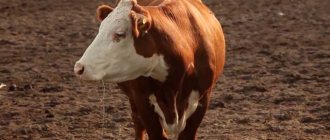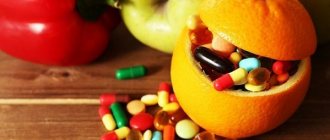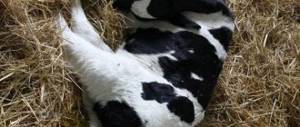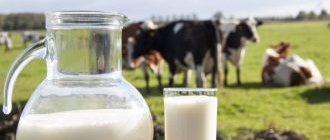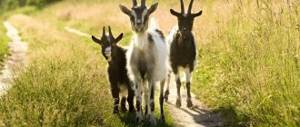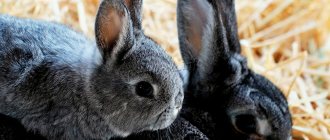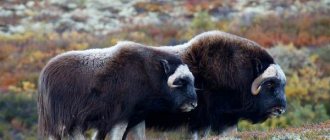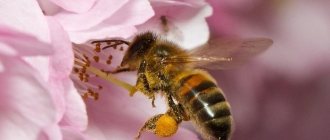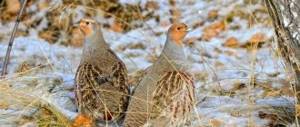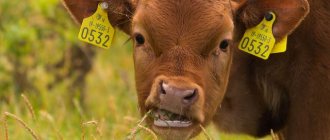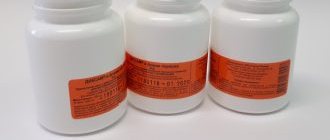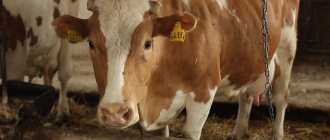Expert opinion
Kosheleva Maria Andreevna
Farmer with 15 years of experience raising goats and cows.
The stomach of cattle is part of the digestive tract, which consists of four sections. Food enters through, then moves along the esophagus to the rumen. Liquid products move into the mesh and then pass into the book. In this section, food turns into mush and is gradually absorbed into the body. In this article we will talk about where the cow's rumen is and what functions it performs.
How does a cow's rumen work?
The cow's rumen is the largest section of the four-chamber stomach, and therefore occupies most of the abdominal cavity. The volume of the adult organ is 200 liters. It is located on the left side from the diaphragm to the pelvic region.
In young cattle, only the abomasum works, since other sections are not developed. Newborn calves cannot chew anything, so they lack the cud. The proventriculus looks like a long single tube with exits for the book, mesh and rumen. However, they are closed tightly with the lips.
The tube continues the esophagus. Due to the small size of the abomasum, the baby must drink milk in small portions. If you feed a calf using a bucket, it may swallow too much milk.
Once in the proventriculus through the lips, the liquid begins to sour. For this reason, the functioning of the digestive system in young animals is disrupted. Therefore, newborn calves need to be watered using a teat or brought to the mother's udder.
When the cubs are two weeks old, their diet includes solid food - hay. With the gradual feeding of roughage into the stomach, the cow's rumen begins to develop. From it, the hay flows to the net, but it does not allow it to pass further through the gastrointestinal tract. This is due to the fact that the food particles are too large.
The animal burps, causing some of the food to fall back into the oral cavity. With the help of saliva and teeth, food is ground to a mushy state. As a result, the young animals develop chewing cud. The calves swallow the gruel, which successfully enters the mesh and further into the intestines through the forestomach.
What chambers does a cow's rumen consist of?
The first section of the stomach consists of three chambers, which are also called “bags”:
- dorsal;
- ventral;
- cranial.
The “bags” are connected to each other through longitudinal grooves. The inner surface consists of muscle cords covered with mucous membrane. Folds form on the shell. The dorsal chamber is considered the largest and is located in the abdominal cavity in a horizontal position.
The ventral one is located in close proximity to the pelvic region, the cranial one is lower in a vertical position relative to the dorsal one. Most often, with gastrointestinal diseases, food stagnates in the last bag.
Microbes in the digestive system
The papillae, which are located on the mucous surface of the proventriculus, are responsible for the absorption of nutrients. Food is digested through the work of microorganisms and bacteria. The latter occupy about 10% of the cavity, which is 7 kg. To increase their quantity, experienced farmers recommend adding clover, timothy and alfalfa to the cattle diet.
Yeasts and fungi are responsible for the production of B vitamins and the breakdown of cellulose. Protein synthesis is carried out under the influence of ciliates. To increase their quantity, it is recommended to feed animals with feed with a high content of legumes. However, in this case the volume of bacteria decreases. In addition, this also applies to grain mixtures.
Symptoms
The disease will not take long to appear; signs appear immediately if the stomach does not work:
- belching disappears and the chewing reflex disappears;
- refusal to eat and open mouth;
- the cow begins to chew the void so that foam comes out;
- nervous tail wagging;
- the cough reflex is triggered;
- breathing is heavy, with shortness of breath.
More on the topic: Is it possible to drink milk if a cow has leukemia?
If food or an object gets stuck in the area of the larynx, it will be visually noticeable. Then the cow gags and tries to push him out. She often succeeds.
When the blockage drops lower, the animal's anxiety increases. When there is a partial blockage, gases regurgitate through the esophagus, and water can reach the stomach. But the digestion process is still disrupted, and the cow’s stomach becomes irreversibly damaged.
Functions of the cow's rumen
The main thing in a cattle diet is hay. Rough food forms a “cushion” when it enters the mouth. In turn, due to the contraction of the cow's rumen, it is constantly shaken. As a result, the food becomes moist, swells and grinds. After this, the animal is allowed to be given succulent and dry food.
The solids help other foods mix with bacteria. After grinding, they move more intensively to the next section - the mesh. Between it and the scar there is an exit consisting of epithelium, but without papillae.
When feeding immediately with succulent or dry food, the food moves towards the liquid contents of the rumen and then settles on the walls. The feed does not mix with each other, which is why the swollen mass does not interact with the microflora.
The bolus of food enters the mesh and then quickly moves through the proventriculus. As a result, most of the microelements are not absorbed and are excreted from the body along with feces. The optimal mode for normal decomposition is created at a temperature of 40 degrees and a pH value of 5-7.
In this case, the following happens in the forestomach:
- fiber breaks down into glucose, and starch into glycogen and amylopectin;
- non-volatile and volatile fats are formed;
- the protein is broken down into amino acids and peptides, and ammonia is also released;
- under the influence of bacteria, fats are converted into glycerides, waxes, lipids, sterols and free fatty acids;
- microflora is responsible for the synthesis of B vitamins.
Expert opinion
Kosheleva Maria Andreevna
Farmer with 15 years of experience raising goats and cows.
One part of the beneficial microelements is absorbed into the body through papillae on the rumen mucosa. The other enters the intestines and proventriculuses, after which it is distributed throughout the body through the blood.
When functioning, the rumen releases an increased amount of gases. If you do not monitor the animal’s diet, you will have to contact a veterinarian for help. The veterinarian will check the condition of the forestomach and prescribe appropriate treatment for the cow's rumen.
However, in the absence of proper therapy, serious diseases develop in the body of cattle. The most common are acidosis and rumen tympany in cows. To provide first aid, the farmer must determine where the cranial chamber is located. This is due to the fact that with the development of pathology, all gases accumulate in this place.
Treatment
An erect stomach not only causes discomfort to the cow, but can also lead to its death. Therefore, treatment should follow immediately after symptoms are detected. Since help must come quickly, many livestock farmers have questions about what can be done at home if the cow has a stomach problem.
First, you should carefully examine the animal. Perhaps the illness occurred due to a foreign object that can be reached. Do this:
- The cow should be properly tied and should not push or move.
- Wrap your hand in a rag up to your shoulder so as not to damage it.
- To prevent the animal from closing its mouth, insert a wedge between the teeth.
- An assistant should place the object between the teeth if the wedge suddenly falls out.
- pour in a little vegetable oil to make the probe glide smoothly.
- you can pour in a little water, up to three liters, to push the object through.
Sometimes, at home, you can force a cow to stretch out its tongue, irritate it in every possible way in order to vomit. The hope is that she will be able to spit out the foreign body.
In addition, antispasmodics can be injected intramuscularly under the skin. If you don’t have a probe at hand, a rubber hose with round edges will do. It is advisable that the diameter does not exceed three and a half centimeters. Hard objects such as sticks should not be used, as they can injure the esophagus.
Sometimes the victim is a calf. Newborn babies often experience bloating. It is not yet developed enough, only the food gutter works and the stomach stops systematically.
More on the topic: Necessary equipment for barns
At the age of two months, the problem disappears with the introduction of dry food. They normalize the functioning of the intestines and stomach. To relieve spasms, no-spa, oxetetracycline and sulfocamphoin help.
When the stomach stops, contraction or stoppage of the proventriculus develops. The area of the hungry pit on the left can be crushed with fists in order to force the stomach to work with physical force.
Livestock breeders often practice treatment using traditional methods. For example, a small calf can be given any vegetable pickle or mineral water to drink to start its stomach.
If you don’t have the necessary medications in your first aid kit or you can’t physically push an object or a lump of food through, there are still options for what to do at home if the cow has a stomach problem. These are folk recipes:
- One hundred grams of yeast is dissolved in warm water, a glass is enough. Let them swell for half an hour. Then add two hundred grams of vodka and one hundred sugar. The resulting liter of liquid is given to the cow to drink twice a day. You need to continue feeding for several days;
- hellebore tincture is mixed with water in a volume of five hundred milliliters. It can also be given to a sick cow;
- A decoction of St. John's wort, yarrow, and flax seeds helps make the stomach work again. It is enough to use twice a day.
If the cow's owners have done all the manipulations at home, but they do not help, they have to seek the help of a veterinarian. Sometimes surgery is required. He may recommend cardiovascular medications with added glucose.
Rumen acidosis
The cause of the pathology is a violation of the pH level in the cavity due to the priority supply of dry food. In addition to direct rumen acidosis, cows experience atony, overflow of the stomach contents, and hypotension.
Early symptoms that can be used to determine the presence of the disease in cattle:
- loss of appetite or complete refusal to feed;
- depressed state, as well as low activity due to the accumulation of gases;
- trembling in the muscles in the rear thighs;
- liquid feces, diarrhea may develop;
- decreased intestinal motility;
- filling the rumen contents with feed lumps.
The last symptom usually occurs when there is an excess of corn in the diet. In this case, the stomach section increases slightly in size and becomes dense. In the absence of timely treatment, the animal cannot move and constantly lies in one place.
Causes
In cattle, problems with the functioning of the stomach are noticed quite often. In some cases this is due to the human factor. The owner gives the cow low-quality food, heavy, too cold or hot food. The cow, in turn, is sometimes not too picky and swallows food that is harmful to itself, and often foreign objects. Harmful to the cow's stomach:
- consumption of poorly chopped root vegetables, corn, pumpkin and other types;
- foreign objects, including nails and stones;
- starvation, when the animal begins to randomly and greedily swallow food provided belatedly;
- fright and, as a result, stomach spasm (a phenomenon often observed in calves), the esophagus narrows greatly and becomes.
Based on these prerequisites, the appropriate recommendations for feeding pets should be followed. In particular, give the cow only fresh food, well crushed to avoid stomach cramps.
Vegetables can be grated or chopped. Corn cobs need to be cleaned. Avoid long breaks between meals.
In some cases, the course of the disease is facilitated by paralysis of the esophagus. This occurs due to injury to the mucous membrane of the esophagus and the muscle wall. In addition, a tumor may grow there due to tuberculosis or leukemia. Inflammation of the brain during infections such as rabies also leads to paralysis.
Preventive actions
Every farmer must take responsibility for keeping cattle and monitor their health. It is necessary to feed cows strictly at the right time, thereby avoiding overfeeding and not allowing them to starve. The feed should be chopped and animals should not graze near potato, beet and cabbage piles.
To prevent foreign matter from entering the esophagus, the pasture and paddock are cleaned regularly and feeders are checked for large objects. In addition, vitamins, minerals and lick salt are added to the food. If the animal does not have enough nutrients, it will begin to lick walls, the ground, and also swallow foreign objects.
